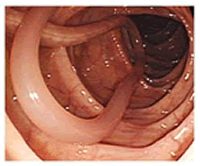|
|
Ascaris
Ascaris is a parasitic roundworm known as the "giant intestinal roundworm". A. lumbricoides species is the largest intestinal roundworm and is the most common helminth infection of humans worldwide. This infection is known as ascariasis. You can see the worms inside of a human large intestine in the photo. Perhaps as many as one quarter of the world's people are infected, with rates of 45% in Latin America and 95% in parts of Africa. Ascariasis is particularly prevalent in tropical regions and in areas of poor hygiene. Other species of the genus Ascaris are parasitic and can cause disease in domestic animals.
Infection occurs through ingestion of food contaminated with feces containing Ascaris eggs. The larvae hatch, burrow through the intestine, travel to the lungs, and finally migrate up the respiratory tract. From there they are re-swallowed and mature in the intestine, growing up to 30 cm (12 in.) in length and anchoring themselves to the intestinal wall.
People can remain asymptomatic for very long periods of time. As larval stages travel through the body, they may cause visceral damage, peritonitis and inflammation, enlargement of the liver or spleen, toxicity, and pneumonia. A heavy worm infestation may cause nutritional deficiency. Additional complications, sometimes fatal, include obstruction of the bowel by a bolus (big ball) of worms (observed particularly in children) and obstruction of the bile or pancreatic duct. More than 796 Ascaris lumbricoides worms weighing up to 550 g [19 ounces] were recovered at an autopsy of a 2-year-old South African girl. The worms had caused torsion and gangrene of the ileum, which were determined to be the cause of death.
Ascaris takes most of its nutrients from the partially digested host food in the intestine. There is limited evidence that it can also pierce the intestinal mucous membrane and feed on blood, but this is not its usual source of nutrition. As a result, Ascaris infection does not tend to produce the anemia associated with some other roundworm infections.
|
|
| |
Ascaris Detox Remedy
Detoxification of all Ascaris and related toxins
$14.95
Read/Write Reviews
|
 Add
To Cart Add
To Cart |
 |
 |
Liquid Detox
Help that itch, burn, rash, infection.
$39.95
|
 Add
To Cart Add
To Cart |
 |
 |
IC-2
The natural alternative to pepto-bismol.
$19.95
|
 Add
To Cart Add
To Cart |
 |
 |
MMS Combo (4oz ea)
The best germicide known to man
$34.95
|
 Add
To Cart Add
To Cart |
 |
 |
|
|
 Arthropod/Vector
Bacteria
Chemicals
Fungus /Mold
/ Yeast Metals Parasites Virus Other
Arthropod/Vector
Bacteria
Chemicals
Fungus /Mold
/ Yeast Metals Parasites Virus Other





